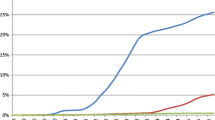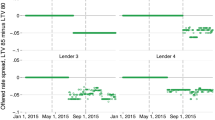Abstract
Credit “screening models” suggest that lenders vary loan rates and debt ceilings across applicants on the basis of credit risk. We argue that regulatory constraints such as Fair Lending Laws may preclude rate sorting while increasing lender use of debt ceilings to adjust for applicant credit risk. Using household data from the 1983 SCF, we find that mortgage rates do not vary with applicant credit risk whereas related studies find that debt ceilings vary with borrower risk attributes. Together, these findings support arguments that regulatory constraints reduce rate sorting while increasing the use of non-price terms in the mortgage contract.
Similar content being viewed by others
References
Avery, Robert, and Gregory Elliehausen. “1983 Survey of Consumer Finances: Technical Manual and Codebook” Federal Reserve (August 1988).
Berger, Allen, N., and Gregory F. Udell. “Collateral, Loan Quality, and Bank Risk,”Journal of Monetary Economics, 25 (January 1990), 21–42.
Boyes, William J., Dennis L. Hoffman, and Stuart A. Low. “An Econometric Analysis of the Bank Credit Scoring Problem,”Journal of Econometrics, 40 (January 1989), 3–14.
Calomiris, Charles, W., and R. Glenn Hubbard. “Firm Heterogeneity, Internal Finance, and ‘Credit Rationing,’”The Economic Journal, 100 (March 1990), 90–104.
Campbell, Tim S., and J. Kimball Dietrich. “The Determinants of Default on Insured Conventional Residential Mortgage Loans,”Journal of Finance, 38 (December 1983), 1569–1581.
Cox, Donald, and Tullio Jappelli. “The Effect of Borrowing Constraints on Consumer Liabilities,”Journal of Money Credit and Banking, 25 (May 1993), 197–213.
Duca, John V., and Stuart S. Rosenthal. “Borrowing Constraints and Access to Owner-Occupied Housing,”Regional Science and Urban Economics, (forthcoming).
Duca, John V., and Stuart S. Rosenthal. “Borrowing Constraints, Household Debt, and Racial Discrimination in Loan Markets.”Journal of Financial Intermediation, 3 (October 1993), 77–103.
Duca, John V., and Stuart S. Rosenthal. “An Empirical Test of Credit Rationing in the Mortgage Market,”Journal of Urban Economics, 29 (March 1991), 218–234.
Fazzari, Steven M., R. Glenn Hubbard, and Bruce C. Petersen. “Financing Constraints and Corporate Investment,”Brookings Papers on Economic Activity, (1988), 141–195.
Flavin, Marjorie. “The Adjustment of Consumption to Changing Expectations About Future Income,”Journal of Political Economy, 89 (1981), 974–1009.
Hall, Robert E., and Frederic Mishkin. “The Sensitivity of Consumption to Transitory Income: Estimates from Panel Data on Households,”Econometrica, 50 (1982), 461–481.
Hayashi, Fumio. “The Effect of Liquidity Constraints on Consumption: A Cross-Section Analysis,”Quarterly Journal of Economics, 50 (February 1985), 1983–2006.
Jaffee, Dwight M., and Thomas Russell. “Imperfect Information, Uncertainty, and Credit Rationing,”Quarterly Journal of Economics, 90 (November 1976), 651–666.
Maddala, G.S.Limited-Dependent and Qualiltative Variables in Econometrics. New York: Cambridge University Press, 1983.
Oliner, Stephen D., and Glenn D. Rudebusch. “Sources of the Financing Hierarchy for Business Investment,”Review of Economics and Statistics, 74 (November 1992), 643–654.
Orgler, Yair E.Analytical Methods in Loan Evaluation. Lexington, Massachusetts: D.C. Heath, 1975.
Perraudin, William R.M., and Bent E. Sorensen. “The Credit-Constrained Consumer: An Empirical Study of Demand and Supply in the Loan Market,”Journal of Business and Economic Statistics, 10 (April 1992), 179–192.
Rehm, Barbara A. (a). “ABA Rebuts Bias Charge in Fed Study on Lending,”American Banker, pp. 1 and 19 (October 15, 1991).
Rehm, Barbara A. (b). “Data on Bias in Lending Sparks Demands for Action,”American Banker, pp. 1 and 9 (October 22, 1991).
Riley, John G. “Credit Rationing: A Further Remark,”American Economic Review, 77 (May 1987), 224–227.
Stiglitz, Joseph E., and Andrew Weiss. “Credit Rationing in Markets with Imperfect Information,”American Economic Review, 71 (June 1981), 393–410.
Thomas, Paulette. “Bank America, Security Pacific Merger Cleared,”Wall Street Journal, pp. A3 and A6 (March 24, 1992).
Tunali, Insan. “A General Structure for Models of Double-Selection and an Application to a Joint Migration/Earnings Process with Remigration,”Research in Labor Economics, 8(B) (1986), 235–282.
Wilcox, David W. “Social Security Benefits, Consumption Expenditure, and the Life Cycle Hypothesis,”Journal of Political Economy, 97 (April 1989), 288–304.
Williamson, Stephen. “Costly Monitoring, Financial Intermediation, and Equilibrium Credit Rationing,”Journal of Monetary Economics, 18 (December 1986), 159–189.
Zeldes, Stephen P. “Consumption and Liquidity Constraints: An Empirical Investigation,”Journal of Political Economy, 97 (April 1989), 305–346.
Author information
Authors and Affiliations
Rights and permissions
About this article
Cite this article
Duca, J.V., Rosenthal, S.S. Do mortgage rates vary based on household default characteristics? Evidence on rate sorting and credit rationing. J Real Estate Finan Econ 8, 99–113 (1994). https://doi.org/10.1007/BF01097032
Issue Date:
DOI: https://doi.org/10.1007/BF01097032




